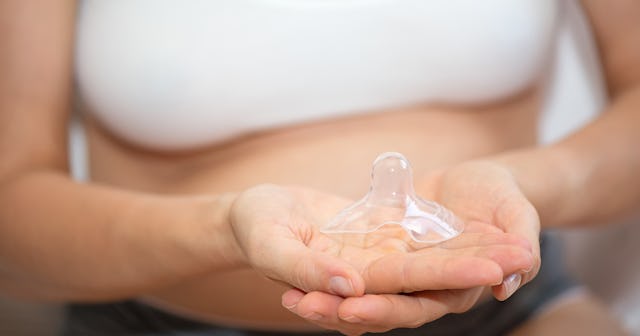The Best Nipple Shields To Help Your Breastfeeding Baby Latch

Nipple shields aren’t necessary for every new breastfeeding mom, but they can absolutely help if nursing isn’t going as well as expected — which, by the way, is totally common for new mamas and babies. We know how challenging and painful nursing can be in the beginning, so if you’re struggling, consider trying a nipple shield. (And if your nipples are in so much pain, it feels like someone’s ripping them off every time you nurse, try nipple cream.)
As an OB-GYN, Dr. Anna Cabeca highly recommends breastfeeding and nipple shields. “I wish I had known about nipple shields when I delivered my first baby… It was not until I met with a La Leche League instructor who gave me nipple shields that I found relief and comfort,” said Dr. Cabeca, who is also a best-selling author and host of show The Girlfriend Doctor. “It changed my breastfeeding experience with all my babies.”
What is a nipple shield?
Made of soft and flexible silicone, a nipple shield is used as a cover for your nipple while nursing. It can help your baby latch until they get into the swing of things, and it also helps ease the pain from breastfeeding, especially in those first few weeks when your nipples are still getting used to Baby’s mouth. You know how your fingers develop calluses when you play guitar? Same for nursing nipples, but more painful. Because they’re nipples.
There are several reasons why a baby might have a poor latch. Your baby might be struggling with the size or shape of your nipples — whether they’re too large, too small, too flat, or too inverted for your little one’s mouth. (Nothing is wrong with your anatomy — sometimes they just aren’t a good fit and require some guidance.) Tongue-tied or premature babies can also struggle to latch in the beginning, while others refuse the nipple altogether without providing a reason. You know how babies can be.
How to use a nipple shield
Gently place the shield over your nipple. The tip of your nipple should fit into the nipple of the shield. Make sure it stays in place. If it doesn’t, apply warm water or a little nipple cream underneath the shield help it stick. If your nipple doesn’t fill out the entire nipple shield, once your baby begins breastfeeding, it should swell and be just fine. But before using a nipple shield, you may want to talk to a lactation consultant to figure out of nipple shields are your best option and to determine the right size.
TIP: Dr. Cabeca recommends applying purified coconut oil to help with sore and cracked nipples! It is totally safe for babies and is soothing for mama.
What are the best nipple shields for breastfeeding?
Dr. Cabeca highly recommends nipple shields with cut-outs that allow you to have more skin-to-skin contact with your little one. There are tons of different sizes to ensure it’s the right nipple shield for you, and it’s encouraged to try out multiple to find the right fit! “I favor the non-DEHP/non-BPA soft silicone nipple shields and would advise trying different ones until you find one that feels better suited for you,” says Dr. Cabeca.
Check out the best nipple shields, nipple guards, and breast shells below!
Best Nipple Shields
Nipple Guards for Nursing
Best Breast Shells
SHOP THE STORY
This article was originally published on